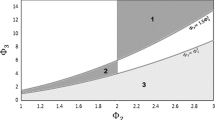Abstract
Failures of machines have a significant effect on the behavior of manufacturing systems. As a result it is important to model this phenomenon. Many queueing models of manufacturing systems do incorporate the unreliability of the machines. Most models assume that the times to failure and the times to repair of each machine are exponentially distributed (or geometrically distributed in the case of discrete-time models). However, exponential distributions do not always accurately represent actual distributions encountered in real manufacturing systems. In this paper, we propose to model failure and repair time distributions bygeneralized exponential (GE) distributions (orgeneralized geometric distributions in the case of a discretetime model). The GE distribution can be used to approximate distributions with any coefficient of variation greater than one. The main contribution of the paper is to show that queueing models in which failure and repair times are represented by GE distributions can be analyzed with the same complexity as if these distributions were exponential. Indeed, we show that failures and repair times represented by GE distributions can (under certain assumptions) be equivalently represented by exponential distributions.
Similar content being viewed by others
References
T. Altiok, Production lines with phase-type operation and repair times and finite buffers, Int. J. Prod. Res. 23 (1985) 489–498.
A. Bobbio and K.S. Trivedi, Computation of the completion time when the work requirement is a PH random variable,Int. Conf. on Analysis and Control of Large Scale Stochastic Systems, Chapel Hill, NC (1988).
J.A. Buzacott, Automatic transfer lines with buffer stocks, Int. J. Prod. Res. 5 (1967) 182–200.
J.A. Buzacott and L.E. Hanifin, Models of automatic transfer lines with inventory banks: A review and comparison, II Trans. 10 (1978) 197–207.
J.A. Buzacott and L.E. Hanifin, Transfer line design and analysis: An overview,1978 Fall IE Conference (1978) pp.277–286.
J.A. Buzacott and J.G. Shanthikumar,Stochastic Models of Manufacturing Systems (Prentice Hall, Englewood Cliffs, NJ, 1993).
Y.F. Choong and S.B. Gershwin, A decomposition method for the approximate evaluation of capacitated transfer lines with unreliable machines and random processing times, II Trans. 19 (1987) 150–159.
Y. Dallery, R. David and X.-L. Xie, An efficient algorithm for analysis of transfer lines with unreliable machines and finite buffers, IIE Trans. 20 (1988) 280–283.
Y. Dallery, R. David and X.-L. Xie, Approximate analysis of transfer lines with unreliable machines and finite buffers, IEEE Trans. Automatic Control 34 (1989) 943–953.
Y. Dallery and S.B. Gershwin, Manufacturing flow line systems: a review of models and analytical results, Queueing Systems 12 (1992) 3–94.
M. Di Mascolo, R. David and Y. Dallery, Modeling and analysis of assembly systems with unreliable machines and finite buffers, II Trans. 23 (1991) 315–330.
Y. Frein, C. Commault and Y. Dallery, Modeling and analysis of closed-loop production lines with unreliable machines and finite buffers, Tech. Report LAG No. 92-123 (1992).
S.B. Gershwin, An efficient decomposition algorithm for the approximate evaluation of tandem queues with finite storage space and blocking, Oper. Res. 35 (1987) 291–305.
S.B. Gershwin, An efficient decomposition algorithm for unreliable tandem queueing systems with finite buffers, in:Queueing Networks with Blocking, eds. H.G. Perros and T. Altiok (North-Holland, Amsterdam, 1989) pp. 127–146.
S.B. Gershwin, Assembly/disassembly systems: an efficient decomposition algorithm for tree-structured network, II Trans. 23 (1991).
L. Gün and A.M. Makowski, Matrix-geometric solution for two-node tandem queueing systems with phase-type servers subject to blocking and failures, Stochastic Models, to appear.
M. Jafari and J.G. Shanthikumar, Exact and approximate solutions to two-stage transfer lines with general uptime and downtime distributions, II Trans. 19 (1987) 412–420.
L. Kleinrock,Queueing Systems, Vol. 1 (Wiley, New York, 1975).
D.D. Kouvatsos, Maximum entropy and the G/G/1/N queue, Acta Informatica 23 (1986) 545–565.
D. Mitra, Stochastic theory of a fluid model of multiple failure-susceptible producers and consumers coupled by a buffer, Adv. Appl. Prob. (September 1988).
M.F. Neuts,Matrix-Geometric Solutions in Stochastic Models: An Algorithmic Approach (The Johns Hopkins Univ. Press, 1981).
V.F. Nicola, A single server queue with mixed types of interruptions, Acta Informatica 23 (1986) 465–486.
Author information
Authors and Affiliations
Additional information
This work was performed while the author was visiting the Laboratory for Manufacturing and Productivity, Massachusetts Institute of Technology, Cambridge, MA 02139, USA.
Rights and permissions
About this article
Cite this article
Dallery, Y. On modeling failure and repair times in stochastic models of manufacturing systems using generalized exponential distributions. Queueing Syst 15, 199–209 (1994). https://doi.org/10.1007/BF01189237
Received:
Revised:
Issue Date:
DOI: https://doi.org/10.1007/BF01189237




